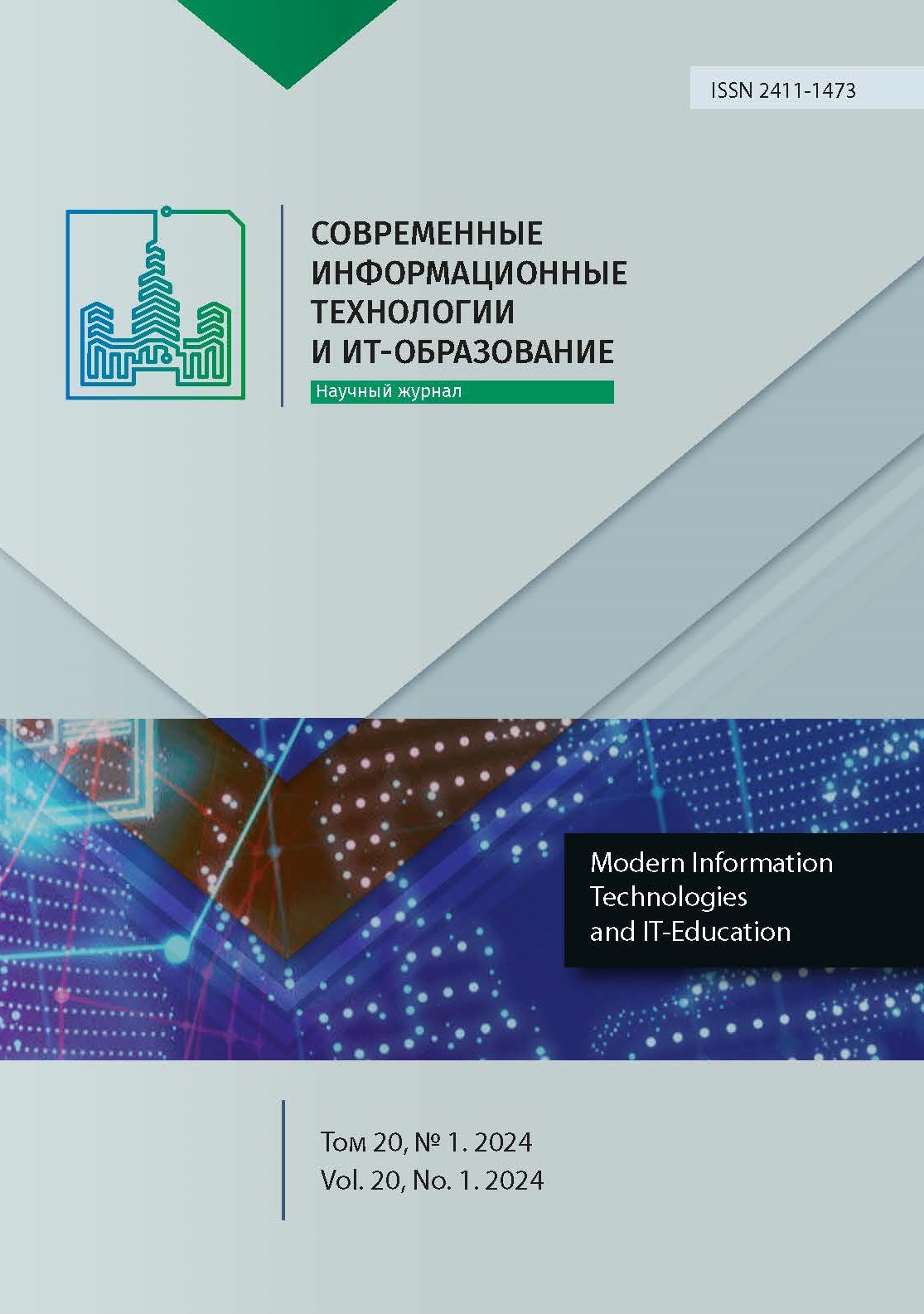Выявление аномалий в поведении ЦП с применением алгоритмов кластеризации библиотеки Scikit-Learn языка программирования Python
Аннотация
Современные компьютерные системы становятся все более сложными. Они предоставляют нам множество возможностей и удобств, однако иногда аномалии в системе могут негативно сказаться на работе компьютера. В таком случае вопрос обнаружения аномалий стоит остро, так как вовремя обнаруженная аномальная активность может предотвратить кибератаку.
В данной статье исследуется проблема выявления аномалий в работе центрального процессора (ЦП) с использованием алгоритмов кластеризации временных рядов. Центральный процессор - это основной вычислительный компонент, отвечающий за выполнение инструкций и обработку данных. Аномалии в работе ЦП могут приводить к сбоям системы, снижению производительности и другим негативным последствиям. Для решения этой проблемы предлагается применение алгоритмов кластеризации, которые позволяют выявить аномалии на основе анализа временных рядов, представляющих поведение ЦП. В статье представлен обзор существующих алгоритмов кластеризации временных рядов и их применение к задаче выявления аномалий в работе ЦП.
Рассматриваются классические методы кластеризации библиотеки Scikit-Learn языка программирования Python, такие как KMeans, DBSCAN, AgglomerativeClustering и AffinityPropagation. Для оценки эффективности предложенных алгоритмов используются различные метрики качества, такие как ARI, AMI, Homogeneity Score, Completeness score, V – measure и Silhouette score. Проводятся эксперименты на реальных данных, полученных из систем мониторинга работы ЦП, чтобы оценить производительность и сравнить результаты различных алгоритмов.
Выявление аномалий ЦП является важной задачей, которая помогает улучшить качество компьютерных систем. Понимание причин аномалий ЦП и имеющихся решений позволяет решить проблемы, связанные с работой процессора. Это в свою очередь способствует повышению производительности, стабильности и надежности компьютерных систем.
Литература
2. Ozer G., Netti A., Tafani D., Schulz M. Characterizing HPC Performance Variation with Monitoring and Unsupervised Learning. In: Jagode H., Anzt H., Juckeland G., Ltaief H. (eds.) High Performance Computing. ISC High Performance 2020. Lecture Notes in Computer Science. Vol. 12321. Cham: Springer; 2020. p. 280-292. https://doi.org/10.1007/978-3-030-59851-8_18
3. Utomo D., Hsiung P.-A. A Multitiered Solution for Anomaly Detection in Edge Computing for Smart Meters. Sensors. 2020;20(18):5159. https://doi.org/10.3390/s20185159
4. Fernando D., Rodriguez M.A., Arroba P., Ismail L., Buyya R. Efficient Training Approaches for Performance Anomaly Detection Models in Edge Computing Environments. arXiv:2408.12855. 2024. https://doi.org/10.48550/arXiv.2408.12855
5. Daraghmeh M., Agarwal A., Jararweh Y. Anomaly Detection-Based Multilevel Ensemble Learning for CPU Prediction in Cloud Data Centers. In: 2024 IEEE Canadian Conference on Electrical and Computer Engineering (CCECE). Kingston, ON, Canada: IEEE Computer Society; 2024. p. 559-564. https://doi.org/10.1109/CCECE59415.2024.10667074
6. Halawa M.S., Díaz Redondo R.P., Vilas A.F. Supervised Performance Anomaly Detection in HPC Data Centers. In: Hassanien A., Azar A., Gaber T., Bhatnagar R., F. Tolba M. (eds.) The International Conference on Advanced Machine Learning Technologies and Applications (AMLTA2019). AMLTA 2019. Advances in Intelligent Systems and Computing. Vol. 921. Cham: Springer; 2020. p. 680-688. https://doi.org/10.1007/978-3-030-14118-9_67
7. Cao C., Blaise A., Verwer S., Rebecchi F. Learning State Machines to Monitor and Detect Anomalies on a Kubernetes Cluster. In: Proceedings of the 17th International Conference on Availability, Reliability and Security (ARES '22). Article number: 117. New York, NY, USA: Association for Computing Machinery; 2022. https://doi.org/10.1145/3538969.3543810
8. Chavan V.D., Yalagi P.S. A Review of Machine Learning Tools and Techniques for Anomaly Detection. In: Choudrie J., Mahalle P.N., Perumal T., Joshi A. (eds.) ICT for Intelligent Systems. ICTIS 2023. Smart Innovation, Systems and Technologies. Vol. 361. Singapore: Springer; 2023. p. 395-406. https://doi.org/10.1007/978-981-99-3982-4_34
9. Huč A., Šalej J., Trebar M. Analysis of Machine Learning Algorithms for Anomaly Detection on Edge Devices. Sensors. 2021;21(14):4946. https://doi.org/10.3390/s21144946
10. Putina A., Rossi D. Online Anomaly Detection Leveraging Stream-Based Clustering and Real-Time Telemetry. IEEE Transactions on Network and Service Management. 2021;18(1):839-854. https://doi.org/10.1109/TNSM.2020.3037019
11. Shiokawa H. Scalable Affinity Propagation for Massive Datasets. Proceedings of the AAAI Conference on Artificial Intelligence. 2021;35(11):9639-9646. https://doi.org/10.1609/aaai.v35i11.17160
12. Kherbache M., Espes D., Amroun K. An Enhanced approach of the K-means clustering for Anomaly-based intrusion detection systems. In: 2021 International Conference on Computing, Computational Modelling and Applications (ICCMA). Brest, France: IEEE Computer Society; 2021. p. 78-83. https://doi.org/10.1109/ICCMA53594.2021.00021
13. Fujiwara Y., Irie G., Kitahara T. Fast Algorithm for Affinity Propagation. In: Proceedings of the Twenty-Second international joint conference on Artificial Intelligence. Volume Three (IJCAI'11). AAAI Press; 2011. p. 2238-2243. Available at: https://www.ijcai.org/Proceedings/11/Papers/373.pdf (accessed 27.01.2024).
14. Molan M., Borghesi A., Cesarini D., Benini L., Bartolini A. RUAD: Unsupervised anomaly detection in HPC systems. Future Generation Computer Systems. 2023;141(C):542-554. https://doi.org/10.1016/j.future.2022.12.001
15. Aljohani A. Optimizing Patient Stratification in Healthcare: A Comparative Analysis of Clustering Algorithms for EHR Data. International Journal of Computational Intelligence Systems. 2024;17:173. https://doi.org/10.1007/s44196-024-00568-8
16. Dodda S., Chintala S., Kunchakuri N., Kamuni N. Enhancing Microservice Reliability in Cloud Environments Using Machine Learning for Anomaly Detection. In: 2024 International Conference on Computing, Sciences and Communications (ICCSC). Ghaziabad, India: IEEE Computer Society; 2024. p. 1-5. https://doi.org/10.1109/ICCSC62048.2024.10830437
17. Giorgino T. Computing and Visualizing Dynamic Time Warping Alignments in R: The dtw Package. Journal of Statistical Software. 2009;31(7):1-24. https://doi.org/10.18637/jss.v031.i07
18. Wang L., Koniusz P. Uncertainty-DTW for Time Series and Sequences. In: Avidan S., Brostow G., Cissé M., Farinella G.M., Hassner T. (eds.) Computer Vision – ECCV 2022. ECCV 2022. Lecture Notes in Computer Science. Vol. 13681. Cham: Springer; 2022. p. 176-195. https://doi.org/10.1007/978-3-031-19803-8_11
19. Bie M., Li W., Fu Q., Chen T., Du Y., Nan L. Energy-Efficient Reconfigurable Acceleration Engine for Polynomial Coefficient Generation of Lattice-Based Post-Quantum Cryptography. Electronics. 2024;13(24):4921. https://doi.org/10.3390/electronics13244921
20. Togbe M.U., et al. Anomaly Detection for Data Streams Based on Isolation Forest Using Scikit-Multiflow. In: Gervasi O., et al. Computational Science and Its Applications – ICCSA 2020. ICCSA 2020. Lecture Notes in Computer Science. Vol. 12252. Cham: Springer; 2020. p. 15-30. https://doi.org/10.1007/978-3-030-58811-3_2
21. Sun L., Guo C., Liu C., et al. Fast affinity propagation clustering based on incomplete similarity matrix. Knowledge and Information Systems. 2017;51:941-963. https://doi.org/10.1007/s10115-016-0996-y
22. Deng D. Research on Anomaly Detection Method Based on DBSCAN Clustering Algorithm. In: 2020 5th International Conference on Information Science, Computer Technology and Transportation (ISCTT). Shenyang, China: IEEE Computer Society; 2020. p. 439-442. https://doi.org/10.1109/ISCTT51595.2020.00083
23. Patel P., Sivaiah B., Patel R. Approaches for finding Optimal Number of Clusters using K-Means and Agglomerative Hierarchical Clustering Techniques. In: 2022 International Conference on Intelligent Controller and Computing for Smart Power (ICICCSP). Hyderabad, India: IEEE Computer Society; 2022. p. 1-6. https://doi.org/10.1109/ICICCSP53532.2022.9862439
24. Shorewala V. Anomaly Detection and Improvement of Clusters using Enhanced K-Means Algorithm. In: 2021 5th International Conference on Computer, Communication and Signal Processing (ICCCSP). Chennai, India: IEEE Computer Society; 2021. p. 115-121. https://doi.org/10.1109/ICCCSP52374.2021.9465539
25. Javed A., Lee B.S., Rizzo D.M. A benchmark study on time series clustering. Machine Learning with Applications. 2020;1:100001. https://doi.org/10.1016/j.mlwa.2020.100001

Это произведение доступно по лицензии Creative Commons «Attribution» («Атрибуция») 4.0 Всемирная.
Редакционная политика журнала основывается на традиционных этических принципах российской научной периодики и строится с учетом этических норм работы редакторов и издателей, закрепленных в Кодексе поведения и руководящих принципах наилучшей практики для редактора журнала (Code of Conduct and Best Practice Guidelines for Journal Editors) и Кодексе поведения для издателя журнала (Code of Conduct for Journal Publishers), разработанных Комитетом по публикационной этике - Committee on Publication Ethics (COPE). В процессе издательской деятельности редколлегия журнала руководствуется международными правилами охраны авторского права, нормами действующего законодательства РФ, международными издательскими стандартами и обязательной ссылке на первоисточник.
Журнал позволяет авторам сохранять авторское право без ограничений. Журнал позволяет авторам сохранить права на публикацию без ограничений.
Издательская политика в области авторского права и архивирования определяются «зеленым цветом» в базе данных SHERPA/RoMEO.
Все статьи распространяются на условиях лицензии Creative Commons «Attribution» («Атрибуция») 4.0 Всемирная, которая позволяет другим использовать, распространять, дополнять эту работу с обязательной ссылкой на оригинальную работу и публикацию в этом журналe.













